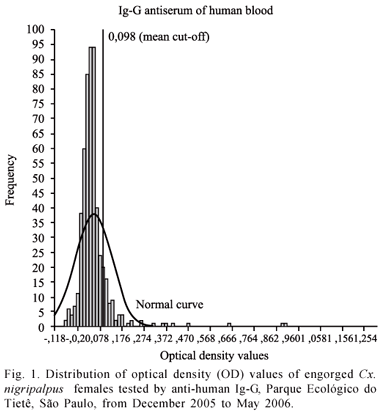The blood feeding of a population of Cx. nigripalpus from Parque Ecológico do Tietê (PET) was investigated using an indirect ELISA protocol. Mosquitoes were captured outside houses. Five hundred sixteen engorged females collected in a reforested area and 25 in an open area were tested. Rodents and dogs were the most common blood sources, accounting for approximately 65.3% of blood meals. Human blood was detected in 10.9%, dog blood in 26.1%, chicken blood in 2.4%, and rodent blood in 39.2% of the 541 insects tested. ELISA failed in identifying the blood sources of 233 engorged females, indicating that the mosquitoes may have fed on a host which was not tested. One hundred six individuals were positive for more than one host. The unweighted human blood index was 0.14 and the rodent/human, human/chicken, and dog/rodent feeding index values were 2.70, 1.51, and 1.33, respectively. Furthermore, rodents are defensive hosts for this haematophagous insect which looks for another host to complete blood-feeding. Considering that rodents are potential reservoirs for Mucambo virus and Saint Louis encephalitis virus and that Cx. nigripalpus feed on the blood of those mammals, we hypothesize that mosquito population in PET could participate in the transmission cycle of those arboviruses. Additionally, this species might be involved in the transmission of Dirofilaria immitis to dogs at this area.
Disease reservoirs; food chain; insect vectors; parasites; zoonoses





